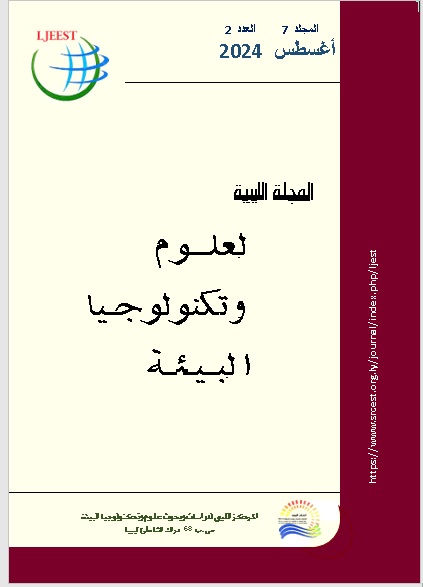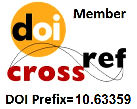تقدير بعض المعادن الثقيلة في اللحوم المجمدة المباعة في مدينة طرابلس، ليبيا
DOI:
https://doi.org/10.63359/0891ds22الكلمات المفتاحية:
السلامة الغذائية، العناصر الثقيلة، اللحوم المجمدةالملخص
الكشف عن المعادن الثقيلة في الأغذية، وخاصة اللحوم، مهم لأسباب غذائية وسلامة المستهلك. تناولت هذه الدراسة محتوى الرصاص، الكادميوم، النحاس، والزنك في اللحوم المبردة. شملت اللحوم الحمراء العضلات، الكبد، والكلى للأبقار، الأغنام، والإبل. أما اللحوم البيضاء، فشملت العضلات والكبد للدجاج. تم جمع ستة وستين عينة من أسواق اللحوم في طرابلس، ليبيا. استخدم مطياف الامتصاص الذري لتحديد تركيزات المعادن الثقيلة، وتم تحليل البيانات بواسطة برنامج SAS. أظهرت النتائج أن تركيزات الرصاص تتراوح بين 0.0020 إلى 0.1033 ملجم/كجم، في حين أن تركيزات الكادميوم تتراوح بين 0.0074 إلى 0.0947 ملجم/كجم. كما أظهرت النتائج أن تركيزات النحاس كانت أقل من الحد المكتشف (BDL) ملجم/كجم في جميع أنواع اللحوم باستثناء الكبد للأبقار، الأغنام، والإبل، حيث تراوحت تركيزات النحاس بين 42 إلى 100 ملجم/كجم. بالنسبة للزنك، فقد تراوحت التركيزات بين BDL إلى 34 ملجم/كجم في العضلات، وبين BDL إلى 34 ملجم/كجم في الكبد، وبين 28 إلى 34 ملجم/كجم في الكلى. بشكل عام، لم تتجاوز تركيزات جميع العناصر الملوثة والأساسية في أعضاء اللحوم المختارة للحيوانات المختارة الحد الأقصى المسموح به من قبل السلطات الصحية
المراجع
Albashr, T. K. M., Ahmed, A. S., & Khidir, Z. K. (2021). Determination of the level of trace elements (copper, lead, cadmium, zinc) and the level of cholesterol and triglycerides in some frozen meat imported in Tikrit markets. IOP Conference Series: Earth and Environmental Science, 735(1), 012004. https://doi.org/10.1088/1755-1315/735/1/012004
Alturiqi, A. S., & Albedair, L. A. (2012). Evaluation of some heavy metals in certain fish, meat and meat products in Saudi Arabian markets. The Egyptian Journal of Aquatic Research, 38(1), 45-49. https://doi.org/10.1016/j.ejar.2012.08.003
Akan, J. C., Abdulrahman, F. I., Sodipo, O. A., & Chiroma, Y. A. (2010). Distribution of heavy metals in the liver, kidney and meat of beef, mutton, caprine and chicken from Kasuwan Shanu market in Maiduguri Metropolis, Borno State, Nigeria. Research Journal of Applied Sciences, Engineering and Technology, 2(8), 743-748.
ANZFA (2001) Australia New Zealand Food Authority Wellington NZ 6036 May, 2001. http://www.anzfa.gov.au
ATSDR (2004). Agency for Toxic Substances and Disease Registry (ATSDR). Division of toxicology, Clifton road, NE, Atlanta, GA.
Araya, M., Olivares, M., & Pizarro, F. (2007). Copper in human health. International Journal of Environment and Health, 1(4), 608-620. https://doi.org/10.1504/IJENVH.2007.018578
Arshad, A., Khalid, S., & Noor, M. J. (2024). Monitoring and Assessment of Toxicological Risks of Poultry Meat Contaminated with Heavy Metals. Biological Trace Element Research, 203, 1-15. https://doi.org/10.1007/s12011-024-04424-w
Brito, G., Diaz, C., Galindo, L., Hardisson, A., Santiago, D. and Garcia, M.F. (2005). Levels of Metals in Canned Meat Products: Intermetallic Correlations. Bulleting of Environmental Contaminants and Toxicology, 42, 309-316. https://doi.org/10.1007/BF01700152
Baykov, B. D., Stoyanov, M. P. & Gugova, M. L. (1996). Cadmium and lead bioaccumulation in male chickens for high food concentrations. Toxicological and Environmental Chemistry,54, 155-159. https://doi.org/10.1080/02772249609358308
Bilandžić, N., Sedak, M., Đokić, M., Varenina, I., Kolanović, B.S., Božić, Đ., Brstilo, M. and Šimić, B. (2014). Determination of zinc concentrations in foods of animal origin, fish and shellfish from Croatia and assessment of their contribution to dietary intake. Journal of Food Composition and Analysis, 35(2), 61-66.
https://doi.org/10.1016/j.jfca.2014.04.006
Bohrer, B. (2017). Nutrient density and nutritional value of meat products and non-meat foods high in protein. Trends in Food Science & Technology, 65: 103-112. https://doi.org/10.1016/j.tifs.2017.04.016
Damin, I. C., Silva, M. M., Vale, M. G. R., & Welz, B. (2007). Feasibility of using direct determination of cadmium and lead in fresh meat by electrothermal atomic absorption spectrometry for screening purposes. Spectrochimica Acta Part B: Atomic Spectroscopy, 62(9), 1037-1045. https://doi.org/10.1016/j.sab.2007.05.007
Demirbaş, A. (1999). Proximate and heavy metal composition in chicken meat and tissues. Food Chemistry, 67(1), 27-31. https://doi.org/10.1016/S0308-8146(99)00103-X
Demirezen, D., & Uruç K. (2006). Comparative study of trace elements in certain fish, meat and meat products. Meat Science, 74, 255-60. https://doi.org/10.1016/j.meatsci.2006.03.012
de Vasconcelos Neto, M. C., Silva, T. B. C., de Araujo, V. E., & de Souza, S. V. C. (2019). Lead contamination in food consumed and produced in Brazil: Systematic review and meta-analysis. Food research International, 126, 108671. https://doi.org/10.1016/j.foodres.2019.108671
Djinovic-Stojanovic, J. M., Nikolic, D. M., Vranic, D. V., Babic, J. A., Milijasevic, M. P., Pezo, L. L., & Jankovic, S. D. (2017). Zinc and magnesium in different types of meat and meat products from the Serbian market. Journal of Food Composition and Analysis, 59, 50-54. https://doi.org/10.1016/j.jfca.2017.02.009
Duncan, D.B. (1955). Multiple range and Multiple F Tests. Biometrics, 11 (1):1-42.
EC (2001). Commission Regulation No. 466/2001 of 8 March 2001, Official Journal of European Communities 1.77/1.
Eisler, R. (1988). Zink Hazards to Fish, Wildlife and Invertebrates: a Synoptic Review. US Fish Wildlife Service, Biology of Reproduction, 85.
El-Faer, M. Z., Rawdah, T. N., Attar, K. M., & Dawson, M. V. (1991). Mineral and proximate composition of the meat of the one-humped camel (Camelus dromedarius). Food Chemistry, 42(2), 139-143. https://doi.org/10.1016/0308-8146(91)90029-N
González-Weller, D., Karlsson, L., Caballero, A., Hernández, F., Gutiérrez, A., González-Iglesias, T., Marino, M. & Hardisson, A. (2006). Lead and cadmium in meat and meat products consumed by the population in Tenerife Island, Spain. Food Additives and Contaminants, 23(8), 757-763. https://doi.org/10.1080/02652030600758142
González Weller, D., Caballero, A., Karlsson, L., Saad, S., & Arooj, F. (2014). Determination of Iron, copper, zinc and manganese in sausage, poultry-rabbit meat, viscera and red meats consumed by the population in the Canary Islands, Spain. Journal of Toxins, 1(1), 7.
https://doi.org/10.13188/2328-1723.1000001
Hill, G. M., & Shannon, M. C. (2019). Copper and zinc nutritional issues for agricultural animal production. Biological Trace Element Research, 188, 148-159.
https://doi.org/10.1007/s12011-018-1578-5
Ihedioha, J. & Okoye, C. (2012). Cadmium and lead levels in muscle and edible offal of cow reared in Nigeria. Bulletin of Environmental Contamination and Toxicology, 88, 422-7. https://doi.org/10.1007/s00128-011-0509-3
Khalafalla, F., Abdel-Atty, N., Mariam, A., Omima I., & Rofaida B. (2015). Assessment of heavy metal residues in retail meat and offals. The Journal of American Science, 11, 12-9.
Kia, S. A., Aslani, R., Khaniki, G. J., Shariatifar, N., & Molaee-Aghaee, E. (2024). Determination and health risk assessment of heavy metals in chicken meat and edible giblets in Tehran, Iran. Journal of Trace Elements and Minerals, 7, 100117. https://doi.org/10.1016/j.jtemin.2024.100117
Liang, G., Gong, W., Li, B., Zuo, J., Pan, L., & Liu, X. (2019). Analysis of heavy metals in foodstuffs and an assessment of the health risks to the general public via consumption in Beijing, China. International Journal of Environmental Research and Public Health, 16(6), 909. https://doi.org/10.3390/ijerph16060909
López Alonso, M., Benedito, J. L., Miranda, M., Castillo, C., Hernandez, J., & Shore, R. F. (2000). Toxic and trace elements in liver, kidney and meat from cattle slaughtered in Galicia (NW Spain). Food Additives & Contaminants, 17(6), 447-457. https://doi.org/10.1080/02652030050034028
LNS (594/2009). Maximum permissible level of lead in food, animal feed and drinking water. Tripoli, Libya.
LNS (681/2009). Maximum permissible level of cadmium in food, animal feed and drinking water. Tripoli, Libya.
Jaishankar, M., Tseten, T., Anbalagan, N., Mathew, B. B., & Beeregowda, K. N. (2014). Toxicity, mechanism and health effects of some heavy metals. Interdisciplinary toxicology, 7(2), 60-72. https://doi.org/10.2478/intox-2014-0009
Manea, I., Manea, L., Radulescu, C., Dulama, I.D., Teodorescu, S., Stirbescu, R.M., Chelarescu, E.D. and Bucurica, I.A. (2017). Assessment of metals level in several meat products obtained through conventional and traditional methods. Romanian Reports in Physics, 69(4), 711.
McDowell, L. R. (2003). Minerals in Animal and Human Nutrition. 2nd ed, 2003, Amsterdam, The Netherlands: Elsevier Science. 660 p.
Milam, C., Dimas, B. J., Jang, A. L., & Eneche, J. E. (2015). Determination of some heavy metals in vital organs of cows and bulls at Jimeta Abattoir, Yola, Adamawa State, Nigeria. American Chemical Science Journal, 8(4), 1-7. https://doi.org/10.9734/ACSJ/2015/17012
Mohamed, N. H., Yahya, G., El Bayoumi, R. M., Hussein, M. A., Cavalu, S., Dahshan, H., Alsayeqh, A.F., Darwish, W.S. & Nasr, E. A. (2023). Detection and health risk assessment of toxic heavy metals in chilled and frozen meat collected from Sharkia province in Egypt. Open Veterinary Journal, 13(12), 1729. https://doi.org/10.5455/OVJ.2023.v13.i12.21
Nkansah, M. A., & Ansah, J. K. (2014). Determination of Cd, Hg, as, Cr and Pb levels in meat from the Kumasi central abattoir. International journal of scientific and research publications, 4(8), 1-4. https://doi.org/10.5455/OVJ.2023.v13.i12.21
Obeid, P. J., Younis, M., & El-Nakat, C. S. (2016). Distribution levels of lead and cadmium within various fresh meat tissues of beef, goat and lamb and their consumption risk assessment. WIT Transactions on Ecology and the Environment, 203, 101-111. https://doi.org/10.2495/EID160101
Okoye, C. O. B., Aneke, A. U., Ibeto, C. N., & Ihedioha, I. J. N. (2011). Heavy metals analysis of local and exotic poultry meat. International Journal of Applied Environmental Sciences, 6(1), 49-55.
Roohani, N., Hurrell, R., Kelishadi, R., & Schulin, R. (2013). Zinc and its importance for human health: An integrative review. Journal of Research in Medical Sciences, 18(2): 144-157.
SAS. 2002. Statistical Analysis System (SAS) 9.00.SAS Institute In., Cary, NC, USA.
Tomović, V.; Jokanović, M.; Šojić, B.; Škaljac, S.; Tasić, T. & Ikonić, P. (2013). Cadmium levels in meat. International 57th Meat Industry Conference, June 10-12 2013, Belgrade, Serbia.
Yabe. J., Nakayama, S. M., Ikenaka, Y., Muzandu, K., Ishizuka, M., & Umemura, T. (2011). Uptake of lead, cadmium, and other metals in the liver and kidneys of cattle near a lead zinc mine in Kabwe, Zambia. Environmental Toxicology and Chemistry, 30: 1892-7.
https://doi.org/10.1002/etc.580
Yakubu, M., Dyola, N., Andrew, E., Sara, G. Y., Hitler, L., & Joseph, I. (2017). Determination of the level of heavy metals in liver and kidney of cow and goat used as meat source in Mubi Adamawa State. International Journal of Research in Environmental Science, 3(3), 1-8.
http://dx.doi.org/10.20431/2454-9444.0303001
WHO (1996). Trace elements in human nutrition and health. World Health Organization. https://www.who.int/publications/i/item/9241561734
التنزيلات
منشور
إصدار
القسم
الرخصة
الحقوق الفكرية (c) 2025 المجلة الليبية لعلوم وتكنولوجيا البيئة (م ل ع ت ب)

هذا العمل مرخص بموجب Creative Commons Attribution-NonCommercial 4.0 International License.















